A Conversation With
Paul Soulellis
February 2020
Paul Soulellis is an artist, publisher, curator, and design educator. He holds a Bachelor of Architecture from Cornell University, and studied typography at the School of Visual Arts and Cooper Union in New York City before running a professional graphic design practice for over fifteen years. His best-known work to-date is Library of the Printed Web, an archive of web-to-print artist books, zines and other ephemera that articulates networked culture through printed artifacts. Paul’s most recent project, Queer.Archive.Work, is a not-for-profit publishing studio, installation space, and non-circulating library in Providence, Rhode Island created to “support artists and writers with free, open access to space and resources for experimental publishing.”
I first discovered Paul’s work in a 2018 interview on Scratching the Surface. I was immediately fascinated by his Printed Web project, and inspired by his fluidly interdisciplinary career. When I began to consider publication as a model for my own graphic design practice, Paul’s work became an important influence on my own. I spoke with Paul about independent publishing, the power of print, and his newest projects in spring 2020.
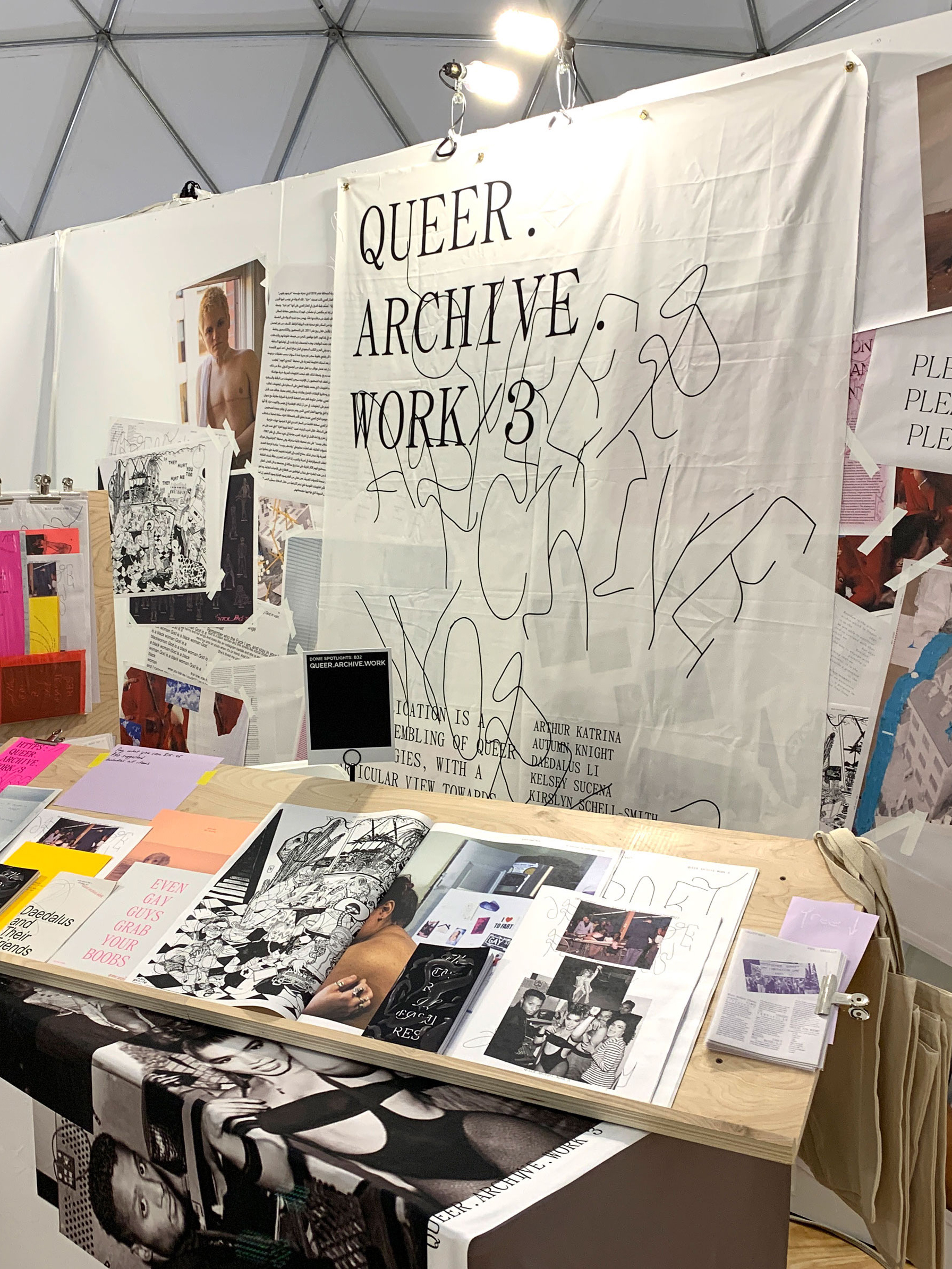
Queer.Archive.Work printed work on display in the project’s exhibit space
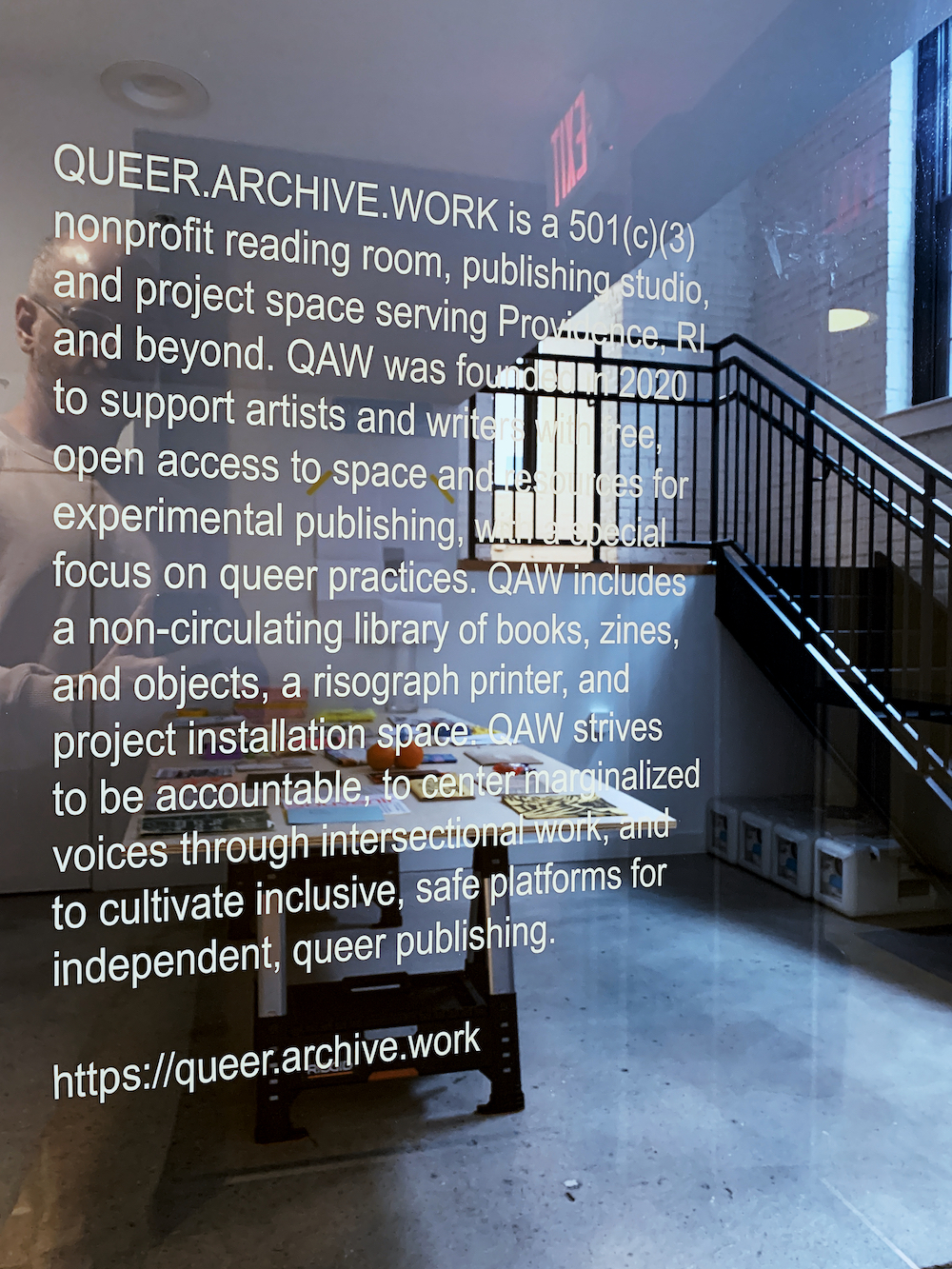
Queer.Archive.Work space in Providence, RI
RW: Your newest project, Queer.Archive.Work, is a nonprofit reading room, publishing studio and workshop space with a mission to “support artists and writers with free, open access to space and resources for experimental publishing, with a special focus on queer practices.” Curating and publishing have long been part of your practice, but this project seems more collaborative and community-oriented than other projects of yours, including The Printed Web. Did the current political climate play any role in your drive to establish a space like QAW? If so, how?
PS: Oh yes, definitely. I felt my practice begin to shift during the 2016 US presidential election, and this shift became more pronounced after the Trump inauguration in January 2017. Previously, I knew that the Library of the Printed Web project had political undertones, in how artists were appropriating work, and where and how network culture was being presented. But I was less consciously concerned with the values of the project; in hindsight, I think my curatorial view was quite limited. Looking back after the inauguration, within a more heightened sense of crisis, I began to see and feel how marginalization and erasure occurs in archives, and how the new administration was actively enabling this. At that moment I made a more conscious decision to point my work in a more political direction. This began by looking at how the printed web plays a part in political protest, and then my practice quickly turned more towards communal care, collaborative work, pedagogy, and other ways that art and design can interfere with hegemonic power.
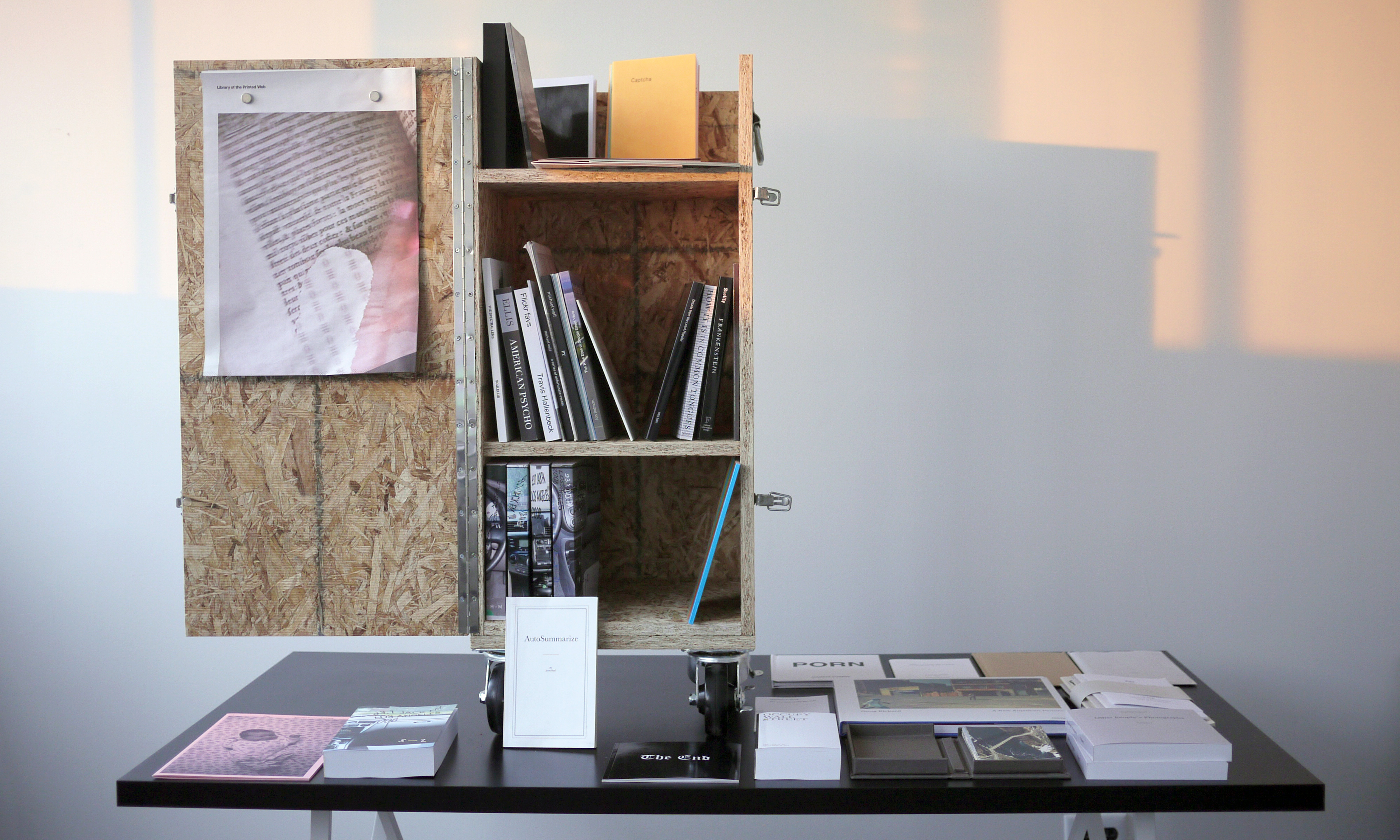
Library of The Printed Web physical collection shown in 2013
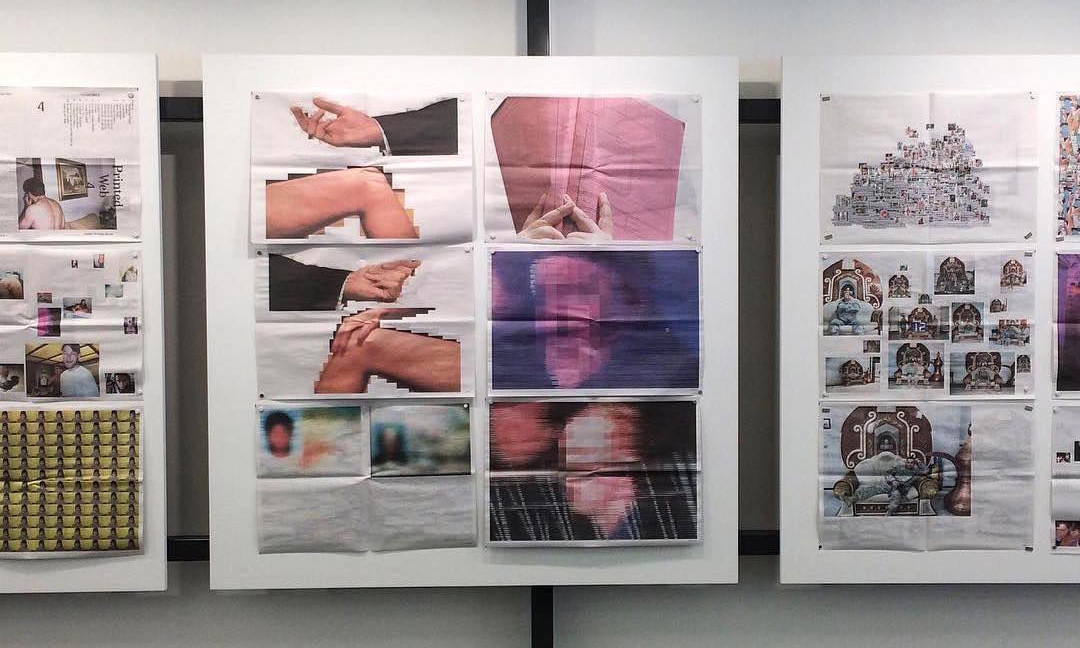
Spreads from a Library of The Printed Web publication
RW:
QAW is not just a studio space where artists can create, print and exhibit work, it’s also a non-circulating library that houses a growing collection of printed books, zines, and other objects. What is missing from public and academic libraries, as well as museums and other gallery spaces that QAW is trying to articulate, reimagine, and perform?
PS:
Erasure within archives is all too common, but it occurs in so many different ways. We saw blatant erasure happen when the Trump administration directed the removal of important climate change language on the Environmental Protection Agency’s website in 2017. Within the space of one weekend, almost 2,000 climate change-related URLs were purged from the EPA’s servers, including information and data that had been accumulating for decades. This is just one example of active, deceptive erasure with the goal of manipulating public perception.
RW: In a conversation with Kate Albers, you discussed conditions of materiality in works of art, and how substrates themselves contain ideological meaning. “I find substrate to be essential, because whether it is material or not, it is political,” you said. With a risograph printer on-premises, and a focus on vernacular formats such as flyers, posters and zines, how does QAW articulate its politic through this specific genre of printed ephemera?
PS:
Materiality has always been an important part of my practice. More specifically, I’m interested in the friction produced when materiality comes right up against network culture. This was part of why I enjoyed The Printed Web so much. Community organizing, networking, and connection happens on digital platforms now; it’s our new normal, and it works well (except when it doesn’t). But a different kind of relationship to content (and people, and ourselves) is possible when these experiences are slowed down. This is why I focus my attention on media and modalities like zines, self-publishing, risograph printing, art book fairs, and face-to-face interaction. I love network culture but I find that these slower experiences more easily encourage criticality, care, connection, and community, rather than fast consumption. They allow the artist/author/participant greater control over how these interactions happen, without the persistent politics of overbearing tech platforms. I’d like to think that these modes of making resist capitalism, even, although that might be more of a stretch! I wrote about this more thoroughly/carefully in Urgentcraft.
RW: You describe your recent publication, Urgency Reader, as an “experiment in publishing as a gesture of call and response: the quick circulation of a charged collection of texts—in some cases raw, in-progress, or sketchy—to a small but deeply engaged audience.” You received eighty responses to an open call for submissions in under two weeks. The material was assembled quickly, and a book was bound just in time to show it at the Odds and Ends Art Book Fair in December 2019. Can you speak more about the urgency of this project?
PS:
I wrote earlier about a “sense of urgency” during and after the election. I experienced tremendous frustration about what was possible in response to this feeling. How could we translate a feeling into something more concrete? Protest is one way but I was interested in bringing a sense of action into my practice so I started experimenting with the idea of urgent publishing. Of course there’s a long history of this, but what it might mean in this specific context felt powerful. I think the first time I used the word was for a two-hour workshop I did at PS1 in August 2018, which started with the idea of “how can we quickly respond to this sense of urgency, right here, right now? Let’s make a collaborative publication.” This was a way to capture emotional output in real time, using simple tools and the energy of a collective gathering. That turned into Urgency Lab, a course I taught at RISD in spring 2019 and at Image Text Ithaca that summer, and a few more urgent publishing workshops. Urgency Reader feels like it was a natural extension of all of these experiments.
RW: How were “quick-responses” and “work-in-progress” important to the process of making Urgency Reader. And how did they influence the publication’s final outcome?
PS:
I’m a real believer in the quick response. I was self-trained to do corporate branding, which was a long, drawn-out process that involved careful, top-down decision-making. It was calculated and performed for maximum profit, stability, and reassurance (i.e. branding!). I think Urgency Reader was a real reaction to this kind of performative capitalism — what if we rushed to get our thoughts down, and share them in a communal way, without time to over-design it or drag it out with bureaucratic decision-making? A publication can create a network of relations through its distribution, and this is what I aim for in all of my publications.
RW: When I want to disseminate something quickly, my first instinct is to go straight to the Web. Digital publishing is practically free, and nothing could be speedier than uploading an image file and a few lines of text to a website or an existing online media platform. Given the urgent nature of this project, why did you choose to print Urgency Reader rather than simply share the work online?
PS:
It’s possible to do both. In publishing, I think materiality plus available tools plus communal distribution creates a different kind of relationship with the content. It resists the urge to keep scrolling, our relentless dependency on the never-ending feed. And I still think that scanning an entire book and posting it online is one of the most radical, generous things one can do — a gesture that pushes up against platform politics and corporate gatekeeping.
RW: Urgency Reader features work by 64 contributors. With 80 initial submissions to the project, the final edit was intended to be “as inclusive as possible.” Can you speak more about inclusivity, and why this was important to you?
PS:
I’ve discovered that curation is a way to exclude. Most commonly it’s a technique that establishes discourse and knowledge through selection based on standards, resulting in exclusivity. That can be a very good thing — say, to make connections and recognize a way of making or being that might otherwise remain less visible — but all too often this can also be a way to create rarified spaces that keep others out (sometimes unintentionally so). I’ve discovered a lot of joy in curation that accepts all. I believe one of the strongest forms of resistance today is plurality. Opening up platforms, publications, and spaces to everyone, not just those who pass a certain standard of quality, of perceived acceptability or relevance. All-inclusive curation leads to surprise, serendipity, and a wider view. Urgency Reader was the clearest example of this so far in my own publishing practice, where most of the submissions came from people without access to traditional modes of power. In the end I was physically unable to include every single contribution, because of limitations in my printing and binding capabilities, but I worked with contributors to compact their submissions to take up less space, in order to maximize participation. In the end, the stapler was the curator — I found a ⅝ inch staples that could bind 130 pages at once, so that’s how the page count was ultimately decided.
RW: I’m very interested in the collaborative nature of publishing. In my own practice, I’m working to develop a community of like-minded people who are interested in non-hierarchical, non-commercial alternatives to client-centred graphic design. That said, reaching out to people (artists, educators and others) with the intent to collaborate is both daunting and logistically challenging, especially as an unknown designer. Can you share any advice for aspiring designer-publishers just starting out?
PS:
Those like-minded people are all around us. We’re trained to believe that they’re somewhere “out there,” in a more robust social media following, in a better school, in a bigger city, or a more well-known art institution. In fact, those like-minded people might be just down the street from you, or in your subway car, or on the other side of the office. I’ve found there to be real joy in 2 or 3 or 9 people showing up for a talk, or a workshop, or purchasing your zine, rather than “filling the room”. Sometimes a home-cooked meal is just as good as (or better than) a banquet. Start small, treasure the interactions, and watch them grow.
RW: library library, the publication project I’m currently working on, is interested in using graphic design as way to engage with, reinterpret, and perform literary texts. Could you share one book (not explicitly about art or design) that you think designers and visual artists should read?
PS:
I would absolutely recommend The Mushroom at the End of the World: On the Possibility of Life in Capitalist Ruins by Anna Lowenhaupt Tsing.
---
Spring 2020 Update — Urgency Reader 2
In March 2020, Paul sent out a call for submissions to Urgency Reader 2, a quick response to the COVID-19 crisis. I submitted a piece of artwork on the theme of relics (or evidence) from previous extroversion. My small piece was published along with the work of over 100 other artists, writers, illustrators and designers.
![]()
Urgency Reader 2, published in spring 2020 during the COVID-19 crisis
![]()
My artwork (right-hand page of spread) published in Urgency Reader 2
PS:
Erasure within archives is all too common, but it occurs in so many different ways. We saw blatant erasure happen when the Trump administration directed the removal of important climate change language on the Environmental Protection Agency’s website in 2017. Within the space of one weekend, almost 2,000 climate change-related URLs were purged from the EPA’s servers, including information and data that had been accumulating for decades. This is just one example of active, deceptive erasure with the goal of manipulating public perception.
Of course, erasure happens in more insidious ways in archives, libraries, and museums all the time, without structures in place to ensure that their collections are balanced and inclusive. In 2018, I was an artist-in-residence at the Internet Archive in San Francisco, where I created the second issue of Queer.Archive.Work. They invited me to focus my residency on the public domain materials that they were celebrating from 1923. On the second day I was there, I discovered that out of more than 3,500 images that had been uploaded to Archive.org during the past year, none contained people of color. The result was a perfect reflection of white supremacy as it existed in popular culture in the 1920s. The Internet Archive is a progressive institution, but they were unaware of the problem because it had never occurred to them to do the work to prevent it. That issue of QAW was assembled as a way to interfere in that process—a small, reparative gesture to bring awareness, and to counter the more hidden ways that white supremacy and other oppressive forces work within archives. As you said, QAW works to articulate and reimagine how we include, amplify, and preserve historically underserved voices. I’m continuing to do that now with more publications and the new QAW publishing space in Providence, where I invite people to work in the space in ways that might not necessarily be valued within traditional institutions, like archives, museums, and art schools.
RW: In a conversation with Kate Albers, you discussed conditions of materiality in works of art, and how substrates themselves contain ideological meaning. “I find substrate to be essential, because whether it is material or not, it is political,” you said. With a risograph printer on-premises, and a focus on vernacular formats such as flyers, posters and zines, how does QAW articulate its politic through this specific genre of printed ephemera?
PS:
Materiality has always been an important part of my practice. More specifically, I’m interested in the friction produced when materiality comes right up against network culture. This was part of why I enjoyed The Printed Web so much. Community organizing, networking, and connection happens on digital platforms now; it’s our new normal, and it works well (except when it doesn’t). But a different kind of relationship to content (and people, and ourselves) is possible when these experiences are slowed down. This is why I focus my attention on media and modalities like zines, self-publishing, risograph printing, art book fairs, and face-to-face interaction. I love network culture but I find that these slower experiences more easily encourage criticality, care, connection, and community, rather than fast consumption. They allow the artist/author/participant greater control over how these interactions happen, without the persistent politics of overbearing tech platforms. I’d like to think that these modes of making resist capitalism, even, although that might be more of a stretch! I wrote about this more thoroughly/carefully in Urgentcraft.
Regarding the risograph specifically: these machines are not easily found, but when they are they’re usually located in liberatory environments that prioritize generosity and access. Printing on the riso is extremely cheap, fast, and simple — on my machine, we can only print one color at a time. Its restrictions (and benefits) lend itself perfectly to urgent publishing. Since they’re not ubiquitous, like inkjet or laser printers, there’s real joy in finding one and discovering the community usually surrounding it. That’s what I’m trying to cultivate at the QAW space.
RW: You describe your recent publication, Urgency Reader, as an “experiment in publishing as a gesture of call and response: the quick circulation of a charged collection of texts—in some cases raw, in-progress, or sketchy—to a small but deeply engaged audience.” You received eighty responses to an open call for submissions in under two weeks. The material was assembled quickly, and a book was bound just in time to show it at the Odds and Ends Art Book Fair in December 2019. Can you speak more about the urgency of this project?
PS:
I wrote earlier about a “sense of urgency” during and after the election. I experienced tremendous frustration about what was possible in response to this feeling. How could we translate a feeling into something more concrete? Protest is one way but I was interested in bringing a sense of action into my practice so I started experimenting with the idea of urgent publishing. Of course there’s a long history of this, but what it might mean in this specific context felt powerful. I think the first time I used the word was for a two-hour workshop I did at PS1 in August 2018, which started with the idea of “how can we quickly respond to this sense of urgency, right here, right now? Let’s make a collaborative publication.” This was a way to capture emotional output in real time, using simple tools and the energy of a collective gathering. That turned into Urgency Lab, a course I taught at RISD in spring 2019 and at Image Text Ithaca that summer, and a few more urgent publishing workshops. Urgency Reader feels like it was a natural extension of all of these experiments.
RW: How were “quick-responses” and “work-in-progress” important to the process of making Urgency Reader. And how did they influence the publication’s final outcome?
PS:
I’m a real believer in the quick response. I was self-trained to do corporate branding, which was a long, drawn-out process that involved careful, top-down decision-making. It was calculated and performed for maximum profit, stability, and reassurance (i.e. branding!). I think Urgency Reader was a real reaction to this kind of performative capitalism — what if we rushed to get our thoughts down, and share them in a communal way, without time to over-design it or drag it out with bureaucratic decision-making? A publication can create a network of relations through its distribution, and this is what I aim for in all of my publications.
RW: When I want to disseminate something quickly, my first instinct is to go straight to the Web. Digital publishing is practically free, and nothing could be speedier than uploading an image file and a few lines of text to a website or an existing online media platform. Given the urgent nature of this project, why did you choose to print Urgency Reader rather than simply share the work online?
PS:
It’s possible to do both. In publishing, I think materiality plus available tools plus communal distribution creates a different kind of relationship with the content. It resists the urge to keep scrolling, our relentless dependency on the never-ending feed. And I still think that scanning an entire book and posting it online is one of the most radical, generous things one can do — a gesture that pushes up against platform politics and corporate gatekeeping.
RW: Urgency Reader features work by 64 contributors. With 80 initial submissions to the project, the final edit was intended to be “as inclusive as possible.” Can you speak more about inclusivity, and why this was important to you?
PS:
I’ve discovered that curation is a way to exclude. Most commonly it’s a technique that establishes discourse and knowledge through selection based on standards, resulting in exclusivity. That can be a very good thing — say, to make connections and recognize a way of making or being that might otherwise remain less visible — but all too often this can also be a way to create rarified spaces that keep others out (sometimes unintentionally so). I’ve discovered a lot of joy in curation that accepts all. I believe one of the strongest forms of resistance today is plurality. Opening up platforms, publications, and spaces to everyone, not just those who pass a certain standard of quality, of perceived acceptability or relevance. All-inclusive curation leads to surprise, serendipity, and a wider view. Urgency Reader was the clearest example of this so far in my own publishing practice, where most of the submissions came from people without access to traditional modes of power. In the end I was physically unable to include every single contribution, because of limitations in my printing and binding capabilities, but I worked with contributors to compact their submissions to take up less space, in order to maximize participation. In the end, the stapler was the curator — I found a ⅝ inch staples that could bind 130 pages at once, so that’s how the page count was ultimately decided.
RW: I’m very interested in the collaborative nature of publishing. In my own practice, I’m working to develop a community of like-minded people who are interested in non-hierarchical, non-commercial alternatives to client-centred graphic design. That said, reaching out to people (artists, educators and others) with the intent to collaborate is both daunting and logistically challenging, especially as an unknown designer. Can you share any advice for aspiring designer-publishers just starting out?
PS:
Those like-minded people are all around us. We’re trained to believe that they’re somewhere “out there,” in a more robust social media following, in a better school, in a bigger city, or a more well-known art institution. In fact, those like-minded people might be just down the street from you, or in your subway car, or on the other side of the office. I’ve found there to be real joy in 2 or 3 or 9 people showing up for a talk, or a workshop, or purchasing your zine, rather than “filling the room”. Sometimes a home-cooked meal is just as good as (or better than) a banquet. Start small, treasure the interactions, and watch them grow.
RW: library library, the publication project I’m currently working on, is interested in using graphic design as way to engage with, reinterpret, and perform literary texts. Could you share one book (not explicitly about art or design) that you think designers and visual artists should read?
PS:
I would absolutely recommend The Mushroom at the End of the World: On the Possibility of Life in Capitalist Ruins by Anna Lowenhaupt Tsing.
---
Spring 2020 Update — Urgency Reader 2
In March 2020, Paul sent out a call for submissions to Urgency Reader 2, a quick response to the COVID-19 crisis. I submitted a piece of artwork on the theme of relics (or evidence) from previous extroversion. My small piece was published along with the work of over 100 other artists, writers, illustrators and designers.
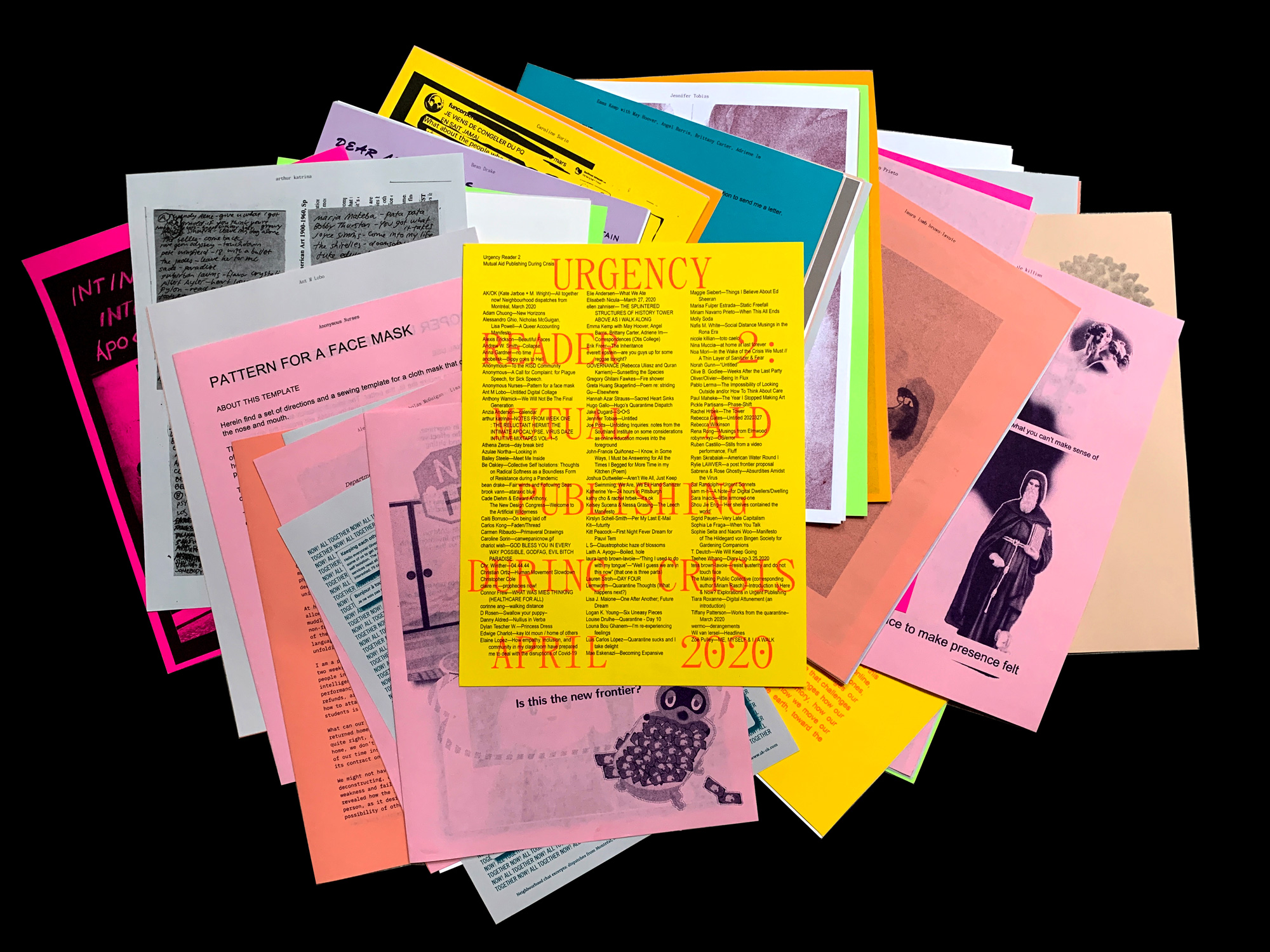
Urgency Reader 2, published in spring 2020 during the COVID-19 crisis
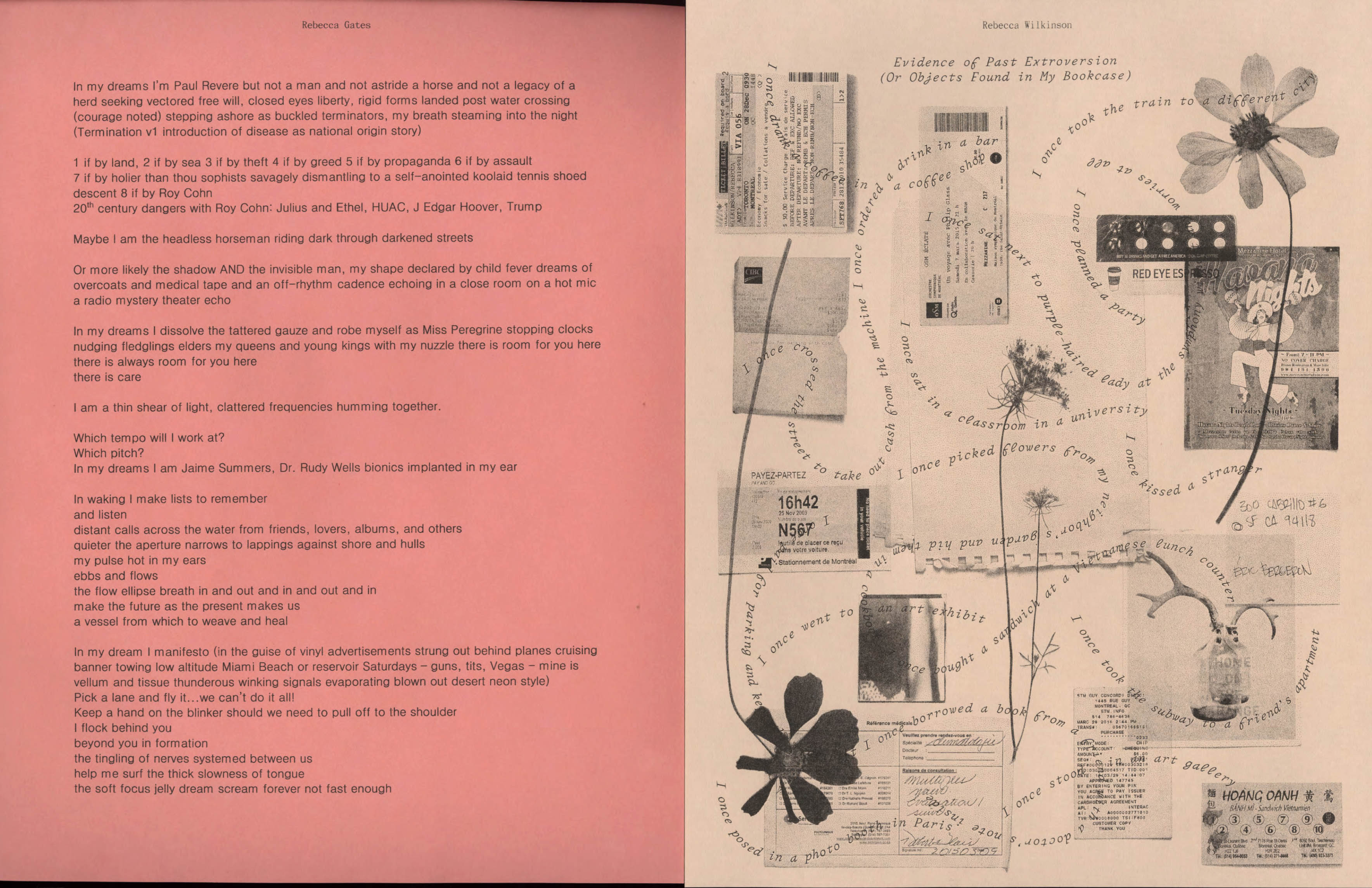
My artwork (right-hand page of spread) published in Urgency Reader 2